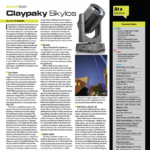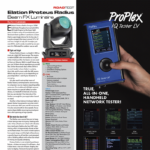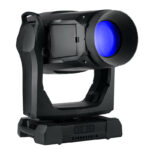Enttec is no stranger to the LED and pixel-related product arena — they offer products ranging from their ultra-high-res LED pixel tape and LED pixel bars to control solutions that make it a breeze to set up large-scale LED installations. If you’re unfamiliar with the company, think back to any of the industry trade shows you may have attended the past few years, and you’ll undoubtedly recall the Enttec booth decked out in pixel products with the staff running around in odd-themed outfits. With their LED Mapper (ELM) software offering, Enttec aims to make mapping content and working with large numbers of individual LEDs easy, powerful, and affordable.
The Software
The ELM software is a free download. It works without a license (output is limited in demo mode), so it is easy to learn before purchasing. The full range of the product is unlocked for output via a license key. It is strictly Windows-only, compatible with Windows 7 and newer (Windows 8 or 10 recommended).
As with any media serving software, the better the processor and graphics card of the machine, the better your performance will be. My PC for testing was an MSI workstation laptop with Intel 6th-generation i7 processor and Nvidia GTX970M 6GB graphics card, and it performed without issue. The manual outlines recommended specifications based on how many layers, what resolution of media you have, and desired playback frame rate — well worth reading when outfitting an installation using ELM. The software can be licensed for up to 512 universes of output per machine, although multiple network cards will need to be utilized for exceeding 256.
The ELM interface is straightforward; similar in layout and workflow to other pixel-mapping software. The software is based upon “stages,” which represent how content is mapped across fixtures in the pixel map. At its simplest, a single stage can be used with all fixtures in it, and one piece of content will be mapped across those fixtures accordingly. Users can create as many stages as desired, with the general idea that each stage can represent a section of the overall installation. Stages also function as content layers in that the same fixtures can exist in multiple stages that are active at the same time — in this case, the active stages use blend modes familiar to anyone who has used Photoshop (e.g. Multiply, Screen, Darken, etc.). This enables complex visual layering of multiple pieces of content over your fixtures. Stages have their own output resolution, which will be dependent on your content dimensions.

Vector-Based Mapping
Mapping LED strips in ELM is a really pleasant and powerful experience due to the fact that the software uses vector-based strip editing. With other pixel-mapping software, you are limited to only placing pixels on an X/Y/Z grid, which makes it difficult (and painful) to map complicated curves or complex forms. One particular installation I worked on utilized over 350 power supplies worth of LED product — all laid out along beautiful, swooping, curving architecture. Needless to say, mapping all of those universes of pixels into an X/Y grid comprised some of the most painstaking weeks of my life. ELM solves this, allowing complete customization of your LED strips by the creation of control points anywhere along a strip in order to create linear segments, Bezier curves, and circles inside of the map.
When placing strips into the stage, you specify the number of LED pixels, shape (line, curve, circle), color order of pixels (a savior in the world of LED tape — GRB, RGB, BRG…), patch address, and two label criteria for filtering in the interface. It is possible to zoom in on the strips and see individual pixels to get things pixel-perfect, and for the consummate perfectionist, users can assign a background image (CAD layout, for example) to the stage window to assist with laying out the installation. This is where the stages come in handy as well, as once you’re done laying out the stage with the entire installation, it’s easy to copy and paste sections of strips into other stages for unique control. There are also various dialog boxes to ease in duplicating and resizing groups of strips. Lastly, there is a simple but very effective testing feature in the mapping window that allows you to flash through strips to ensure mapping, color alignment, and patch are all correct.

Importing Content
The media tab in ELM deals with the content side of things — and it’s pretty straightforward. With the proper codecs, the documentation states that there aren’t any video size or resolution constraints, although of course the larger and heavier the video files you’re trying to play back the slower the application will tend to run. There is a handy transcode button in the media window that will convert videos down a manageable mpeg4 video file. Inside of the media window, you can load the usual formats: video files, image files, use some of their built-in effects, and generate text tickers.
Where ELM shines is in its ability to play back from real-time capture devices (from capture card, webcam), live video streams from the web, and even via Spout inputs (nerd choir rejoice!). Spout is the Windows-based equivalent of Syphon on the Mac ecosystem, and is a framework for passing video streams between applications with very little latency. This means that you can play back any content in ELM from any application that supports Spout — meaning real-time control over your LED installations from Resolume, Isadora, and many other pieces of software. As soon as I saw this feature in action, I immediately thought of ways I could use ELM to drive content from other applications in interactive installations, saving time and processing by letting ELM do the heavy lifting of breaking down a video stream into pixels.

Media Playback
For output, ELM has a “Live” window that acts like a traditional VJ interface. The live controls within the application are quite limited, and would be fine in a pinch for simple uses, but I found that the software would probably be best suited for actual live control by sending video via Spout from a real-time video control software like Resolume. ELM can be controlled via Art-Net from a lighting desk as well, with each stage comprising its own fixture (like a layer of content). ELM also has a “Scheduling” window that enables it to run programs (called Playlists) autonomously based on time of day, sunrise, sunset, etc. given that you set the GPS location appropriately in the settings window (which this reviewer might not have done and wondered why LEDs were strobing way before the coffee maker started).

Output Protocols
Currently, ELM outputs signal via Art-Net, sACN, or via DVI/HDMI to go straight to a projector or other display. This makes it a great solution for any installation utilizing LED strips or bulk LED pixel products that uses these protocols. One feature I hope to see in a future expansion is the addition of Color Kinetics KiNET protocol. Enttec sent me both their stable and beta versions of the software to base this review on, and I was very impressed overall — the software does have a few very minor interface quirks, but the developer was quick to respond to feedback and the roadmap for ELM has a lot of really great improvements on the horizon. Purchasing a software license includes lifetime software updates, and for the price, ELM is an exceptionally powerful tool for working with pixel-based LED installations that is well worth taking a look at adding to the digital workbox.

At a Glance
Pleasant and Powerful Pixel Mapping Software
Enttec’s E.L.M. (Enttec LED Mapper) pixel-mapping software uses “stages” to represent how content is mapped across fixtures in a pixel map. These stages also function as content layers. The underlying architecture — vector-based strip editing — makes E.L.M. a pleasant and powerful alternative to placing pixels on an X/Y/Z grid, especially for designs involving swooping linear shape and circular forms.
Enttec LED Mapper (E.L.D.)
PROS:
Easily able to create complex mapping formations: splines, circles
Very affordable
Lifetime software updates included
Easy to navigate, easy to learn, simple and familiar interface
Integrates with other visual software via Spout
Powerful control via Art-Net
CONS:
Some interface quirks make mapping a bit tedious (must use arrow keys vs. drag-and-drop for placing strips)
Not ideal as standalone VJ application
No KiNET support currently
Versions/MSRP:
Student Edition/Basic License (16 universes output): $200
Professional Edition (96 universes output): $800
Architect Edition (512 universes output): $2,500
Company: Enttec
More Info: www.enttec.com; www.plsn.me/Enttec-ELM



